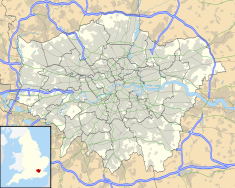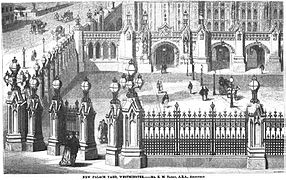New Palace Yard
| New Palace Yard | |
|---|---|
 View of New Palace Yard in 2017, looking south-east | |
| Type | Open courtyard |
| Location | Westminster, London, England |
| Coordinates | 51°30′02″N 0°07′31″W / 51.5005°N 0.1254°W |
| Area | Palace of Westminster |
| Built | circa 1100 |
| Governing body | Parliament of the United Kingdom |
New Palace Yard is a yard (area of grounds) northwest of the
Location

New Palace Yard takes up the north-west corner of the grounds of the Palace of Westminster. It is bordered to the north by Bridge Street, to the east by the Palace's North Front and
Description

The yard is laid out as a garden with a formal avenue of lime trees, benches of Portland stone and a central lawn surrounded by an oval roadway. Around the outside are a number of old catalpa trees. A fountain in the central lawn was installed in 1977 to commemorate the Silver Jubilee of Elizabeth II and recalls the lost medieval fountain of Henry VI.[1] The fountain stands in an octagonal pool in the centre of which is a large welded steel sculpture by Walenty Pytel. The sculpture is decorated with depictions of birds and beasts from six continents and is surmounted by a gilded crown.[3]
History
The name of New Palace Yard refers to the first Palace of Westminster, built by the Anglo-Saxon king Edward the Confessor around 1050. The yard was created after William II of England constructed Westminster Hall in 1097 and was given the appellation "New" to distinguish it from Old Palace Yard a few hundred metres further south. For several hundred years, it was probably a patch of low-lying open marshy ground or perhaps even an inlet, prone to flooding up to very recent times. A rapid increase in the level of the Thames necessitated the construction of a river wall on the yard's eastern side in the 12th century.[4] It was reclaimed by laying down cobbles on successive layers of debris that had accumulated over the years[5] and was laid out as an open space by the late thirteenth or early fourteenth century. Thereafter, as Westminster grew, the yard came to be surrounded by buildings and walls.[4]
The yard's function in relation to the Palace of Westminster was similar to that of an
The interior of the yard was dominated for centuries by a large cupola-topped fountain built by Henry VI in 1443, which stood until the late 17th century.[1] According to the 16th century historian John Stow, the fountain, which was known as the Great Conduit, was made to run with wine to mark coronations and other great state events.[6] The remains of the fountain were rediscovered in the 1970s during the construction of the underground car park.[1]
Several executions and mutilations took place there: in 1580 the Puritan attorney
Tournaments and royal festivities were also staged there.
Changes to the layout of New Palace Yard
New Palace Yard was originally much larger than it is today. An etching by Wenceslaus Hollar, published in 1647, shows the area as an enclosed rectangle with houses flanking Westminster Hall on both sides, Henry VI's fountain and stands for coaches in the centre, a row of shops, taverns and coffee-houses on the north side and a large square gatehouse on the west side giving access to King Street, built by Henry VIII in 1532 and demolished in 1723.[10] The gatehouse was built by Richard III[10] and stood until 1707. A tower to the north side was built under Edward I and was demolished in 1715; it housed the bell known as Great Tom.[11]
Many of the buildings around New Palace Yard were swept away in the 1750s by the urban redevelopment that accompanied the construction of Westminster Bridge. Bridge Street was built to the north of the yard, Parliament Street to connect the Palace with Charing Cross, and Abingdon Street to connect it with Millbank.[12] A row of buildings separated the yard from Bridge Street until they were demolished in 1866–7, opening up the yard to public view.[3]
-
View of New Palace Yard in 1647, looking west
-
View of New Palace Yard in 1807, looking south-west
-
View of New Palace Yard in 1868, looking east
In the 18th and 19th centuries, the perimeter of New Palace Yard was occupied by coffeehouses and taverns. It provided a site for public meetings such as the September 1838 rally in support of the
Between 1972 and 1974, an underground car park with 450 spaces was constructed underneath the yard for £2.5 million (equivalent to £35,100,000 in 2021).[1][2]
Terrorist attacks
New Palace Yard has twice been the scene of terrorist attacks. On 31 March 1979, an Irish National Liberation Army car bomb killed MP Airey Neave as he exited the underground car park at New Palace Yard.[14] On 22 March 2017, an Islamic terrorist crashed a car into the perimeter fence of the Palace grounds, after driving into pedestrians on the Westminster Bridge.[15][16] After abandoning the vehicle, he ran into the New Palace Yard and fatally stabbed PC Keith Palmer, an unarmed police officer guarding the Carriage Gates.[17] His armed colleagues then shot at the terrorist who later died at the scene.[18][19]
See also
References
- ^ Houses of Parliament. Retrieved 12 May 2010.
- ^ ISBN 978-0-11-701392-6.
- ^ ISBN 978-0-333-57688-5.
- ^ ISBN 978-1-901992-50-2.
- ISBN 978-0-19-958569-4.
- ISBN 978-0-19-160879-7.
- ISBN 978-1-4456-1571-4.
- ^ ISBN 978-0-8264-2380-1.
- ISBN 0907383890.
- ^ ISBN 978-0-520-22715-6.
- ^ Shakespeare, William (1839). The Pictorial Edition of the Works of W. Shakespeare, 1: Histories. Charles Knight and Company. p. 85.
- ISBN 978-0-521-83076-8.
- ^ "New Palace Yard, Westminster". The Builder: 29. 11 January 1868.
- ^ Hoggart, Simon (31 March 1979). "Car bomb kills MP Airey Neave". The Guardian. Retrieved 26 March 2017.
- ^ Gilchrist, Karen (23 March 2017). "London police name Parliament attacker as British-born Khalid Masood, age 52". CNBC. Retrieved 24 March 2017.
- ^ "London attack: Four dead in Westminster terror attack". BBC News. 22 March 2017.
- ^ "London attack – latest updates". BBC News. Retrieved 22 March 2017.
- ^ Boyle, Danny; Evans, Martin (22 March 2017). "Parliament shooting: Knifeman shot by police after charging through Westminster gates and stabbing officer". The Daily Telegraph. Retrieved 22 March 2017.
- ^ Rayner, Gordon; McCann, Kate (23 March 2017). "London attack: Cabinet minister's bodyguard shot Westminster terrorist". The Daily Telegraph. Retrieved 24 March 2017.




